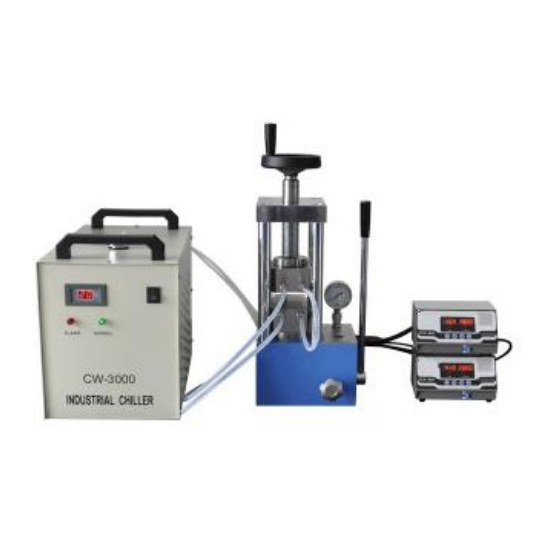Manual Hydraulic Press: A Versatile Tool for Precision and Control
A manual hydraulic press is a mechanical device that uses hydraulic force to perform tasks such as pressing, compressing, or molding materials. Known for its simplicity and efficiency, the manual hydraulic press is a staple in laboratories, workshops, and small-scale manufacturing facilities.
● How Does a Manual Hydraulic Press Work?
The press operates on Pascal's Principle, which states that pressure applied to a confined fluid is transmitted equally throughout the fluid. In a manual hydraulic press, force is applied manually to a lever or pump, which compresses a hydraulic fluid within a cylinder. This action generates a much larger force at the output, allowing the press to exert significant pressure on a workpiece.
● Key Features of Manual Hydraulic Presses
1. Compact Design
- Typically designed for bench-top or portable use, making it ideal for limited spaces.
2. Adjustable Pressure Control
- Pressure levels can be precisely controlled, often using a built-in pressure gauge.
3. Durable Construction
- Made from high-strength materials such as steel to handle high pressures and repeated use.
4. Ease of Operation
- Requires minimal training to operate, making it accessible for both professionals and beginners.
5. Customizable Dies and Plates
- Compatible with various molds, dies, and platens for different applications.
● Applications of Manual Hydraulic Presses
1. Battery Research and Development
- Compressing electrode materials or powders during the fabrication of batteries and supercapacitors.
- Used in preparing coin cell components and testing materials under pressure.
2. Material Testing
- Compacting powders or preparing samples for material characterization studies.
- Common in metallurgy, polymer testing, and composite material development.
3. Molding and Forming
- Creating small-scale molds for prototyping and experimentation in labs or workshops.
4. Jewelry and Crafts
- Pressing materials for custom designs in jewelry or artistic projects.
5. Pharmaceuticals
- Compacting powders into tablets for research or small-batch production.
6. Ceramics and Composites
- Pressing ceramic powders and composite materials for structural or functional prototypes.
● Advantages of Manual Hydraulic Presses
1. Affordability
- Cost-effective compared to automated or electrically powered hydraulic presses.
2. Precision
- Allows fine control over pressure levels, making it suitable for delicate or detailed tasks.
3. Portability
- Lightweight and compact designs can be easily moved and used in different locations.
4. Energy Efficiency
- Requires no external power source, reducing energy costs.
5. Versatility
- Can handle a wide range of materials and applications, from metals to polymers and ceramics.
● Limitations of Manual Hydraulic Presses
1. Labor-Intensive
- Requires physical effort, making it less suitable for high-volume or continuous operations.
2. Limited Pressure Capacity
- Maximum pressure output is lower compared to powered hydraulic presses.
3. Slower Operation
- Manually operated presses take longer to perform tasks compared to automated systems.
4. Smaller Workpieces
- Best suited for small to medium-sized materials and components.
● Key Components of a Manual Hydraulic Press
1. Frame
- Provides structural support and ensures alignment during pressing operations.
2. Hydraulic Cylinder
- The core component that houses the hydraulic fluid and piston, generating force.
3. Hand Pump or Lever
- Used to manually apply pressure to the hydraulic system.
4. Platen (Press Plate)
- The surface where materials are placed for compression or molding.
5. Pressure Gauge
- Displays the applied pressure for precise control.
● Maintenance Tips for Manual Hydraulic Presses
1. Regular Inspection
- Check for leaks, wear, and damage to ensure safe operation.
2. Hydraulic Fluid Maintenance
- Use the recommended hydraulic fluid and replace it periodically to maintain efficiency.
3. Lubrication
- Keep moving parts well-lubricated to prevent wear and tear.
4. Alignment Checks
- Ensure proper alignment of the press plate and cylinder for consistent results.
5. Cleaning
- Remove debris and contaminants to prevent damage and maintain performance.
● Selecting the Right Manual Hydraulic Press
When choosing a manual hydraulic press, consider the following factors:
1. Pressure Capacity
- Determine the maximum pressure required for your specific applications.
2. Workpiece Size
- Ensure the press accommodates the dimensions of your materials.
3. Build Quality
- Look for robust construction materials for durability and long-term use.
4. Ease of Use
- Opt for presses with ergonomic designs and user-friendly controls.
5. Accessories and Compatibility
- Check for compatibility with different dies, molds, or tools.
● Innovations in Manual Hydraulic Press Technology
1. Integrated Digital Readouts
- Displays precise pressure readings for enhanced control.
2. Advanced Safety Features
- Includes overload protection and ergonomic designs to reduce user fatigue.
3. Portable Models
- New lightweight designs for on-the-go applications.
● Conclusion
A manual hydraulic press is an essential tool for small-scale manufacturing, research, and development. Its simplicity, affordability, and versatility make it an indispensable asset in laboratories, workshops, and creative spaces. Whether you’re fabricating components, testing materials, or crafting unique designs, a manual hydraulic press provides the precision and control needed to achieve high-quality results.


